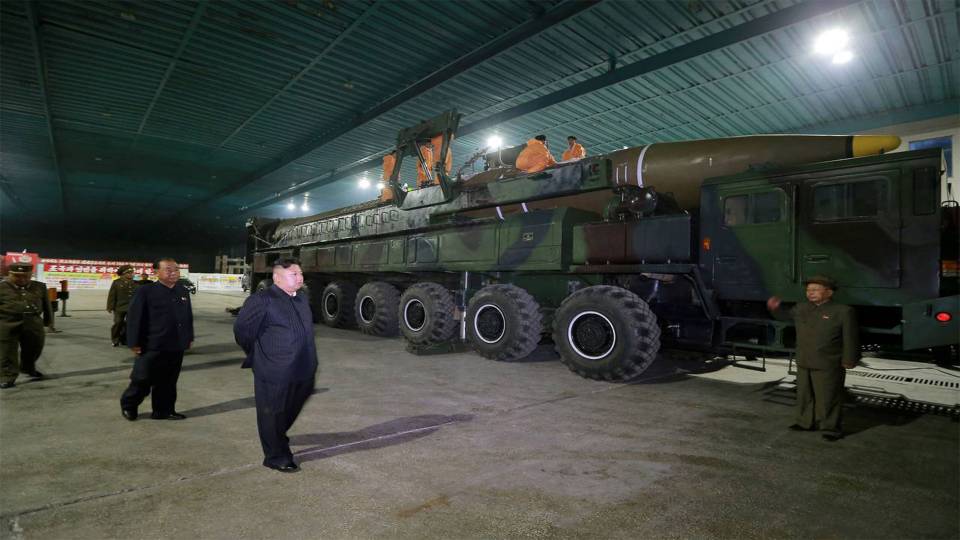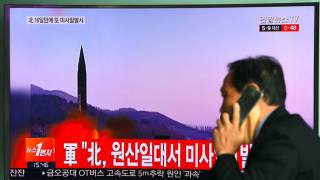North Korea Test-Fires Highest Missile Yet After Two-Month Hiatus
North Korea fired what was likely an intercontinental ballistic missile into waters off Japan early Wednesday local time, U.S., Japanese and South Korean authorities said, ending a more than two-month hiatus from Pyongyang and threatening to ramp up tensions with the U.S. and in the region.
The launch demonstrated a trajectory that could put Washington in range of North Korean missiles, independent experts said. It triggered an unusually robust reaction from South Korea, which quickly responded with a battery of test-firings of its own.
The launch came weeks after U.S. President Donald Trump visited the region and roughly a week after he redesignated North Korea as a state sponsor of terror. Mr. Trump, speaking to reporters Tuesday, mentioned the North Korean missile launch and vowed, “We will take care of it,” without specifying what actions he might take.
White House press secretary Sarah Sanders said on Twitter that Mr. Trump had been briefed on the launch while the missile was still in the air.
The missile, which Pentagon spokesman Col. Robert Manning said had been initially identified as an ICBM, was fired at 2:47 a.m. Pyongyang time—1:17 p.m. Tuesday in Washington—from a site about 20 miles north of the capital, Pyongyang. It flew about 620 miles before splashing down in the waters between Japan and the Korean Peninsula inside Japan’s exclusive economic zone, which extends 200 nautical miles from the Japanese coast.
Despite the missile landing relatively close to its launch point, South Korea’s Joint Chiefs of Staff said it was a “long-range” missile fired on a very steep trajectory, staying aloft for almost an hour and reaching an altitude of about 2,800 miles—roughly 11 times as high as the international space station.
North Korea has increasingly turned to such so-called lofted-trajectory launches in recent months to test its missiles at extended ranges without having them fly a long distance.
The missile “went higher, frankly, than any previous shots,” U.S. Defense Secretary Jim Mattis said. “The bottom line is it’s a continued effort to build a…ballistic missile threat that endangers world peace, regional peace and certainly the United States.”
Wednesday’s test demonstrated a trajectory that could put Washington, D.C., within range of North Korean missiles, said Melissa Hanham, a senior research associate at the Middlebury Institute of International Studies in Monterey, Calif.
“If the numbers hold, this test will demonstrate a much further range than ever tested before,” Ms. Hanham said.
David Wright, a physicist and co-director of the Global Security Program at the Union of Concerned Scientists, came to the same conclusion in an analysis shortly after the launch. He noted, however, that if the North were to use a heavier nuclear warhead, as it would if making an actual attack, it was unlikely that Wednesday’s missile would have been able to reach the U.S. capital.
“Firing at night, from a potential mobile missile, demonstrates that North Korea is closer than ever to a credible nuclear deterrent against the United States,” said Abraham Denmark, a former senior Asia policy official at the Pentagon during the Obama administration and now a director at the Wilson Center think tank.
Within six minutes of the North’s launch, South Korea responded with a simultaneous test-firing of missiles from its army, navy and air force, calibrated to the distance to the North Korean launch site but aimed toward the waters between Korea and Japan, the South’s Joint Chiefs said.
While the South has also reacted to previous North Korean missile launches by firing its own missiles, Wednesday’s response was stronger and faster than in the past. The authorities said the South’s military was on high alert and working closely with the U.S. to guard against further provocations.
In recent months, North Korea has begun to vary the time and location of its test launches. The unusually early hour of Wednesday’s missile test, its occurrence in the generally less active period of late November, and the use of a launch site not often employed by the North appeared designed to show off Pyongyang’s ability to fire missiles under less predictable circumstances.
A North Korean Foreign Ministry spokesman said in the late hours on Tuesday—just hours before the launch—that speculation that North Korea was preparing for another “provocation” before Christmas were “nothing but slanders to ‘demonize’” the North.
“Current situation evidently shows that it is only a matter of time that a nuclear war breaks out on the peninsula due to Trump’s war mania,” Jo Chol Su, director of press for the Foreign Ministry’s Institution for American Studies, was quoted as saying by North Korea’s state news agency.
Mr. Jo also complained in his statement about the U.S.’s recent decision to relist North Korea as a state sponsor of terrorism, calling it “baseless allegations” that were “further increasing our vigilance.”
Before the test-firing—the 20th missile North Korea has fired this year—officials in Washington and Seoul openly wondered about the reasons behind the relatively long break in missile or nuclear tests from Pyongyang.
Just hours earlier on Tuesday in Seoul, South Korea’s top minister on North Korean affairs, Cho Myoung-gyon, played down the silence, noting that the North rarely fires missiles during the final months of the year.
Mr. Cho, South Korea’s Minister of Unification said he was expecting North Korea to complete its nuclear and missile program “very soon” and to declare its program completed perhaps as early as next year.
U.S. Secretary of State Rex Tillerson said in a statement after the launch that “diplomatic options remain viable and open, for now,” adding the U.S. wants “a peaceful path to denuclearization.”
The most recent previous North Korean launch was an intermediate-range ballistic missile fired over the Japanese mainland on Sept. 15.
In Washington, U.S. officials said they had seen movement in North Korea earlier this week suggesting an imminent launch of a land-based missile.
“They’re testing how good the U.S. is at picking up on the signals—it’s a test of seeing how quickly they can get out a missile, a way to test their ability conduct a pre-emptive strike,” said Rodger Baker, lead Asia analyst for geopolitical consulting firm Stratfor.
Mr. Baker, based in Austin, Texas, said the North in its recent nighttime tests appeared to have tried fueling a missile horizontally before rolling it out of the hangar and then raising it to a vertical launch position—all moves aimed at reducing the preparation time for a launch.
“They’re looking for ways to shorten the waiting time from the time the missile is visible to the time that it’s launched, to take down the U.S. confidence that it can take out a missile before it takes off,” he said.






















